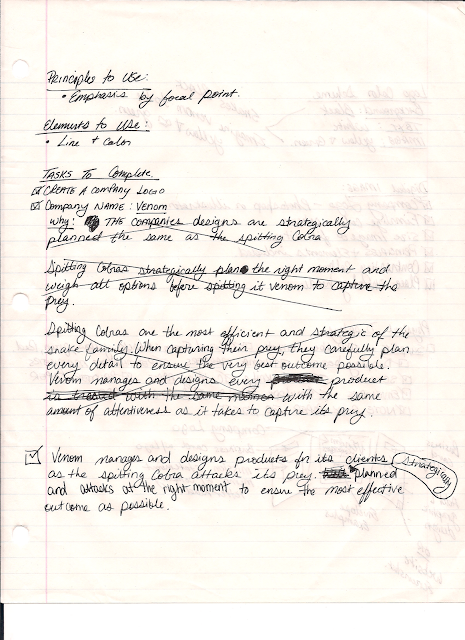Greetings viewers,
My
name is Mat Lasky and I am the owner and the designer at Venom Graphics. Look
up Venom Graphics at my website to view portfolio. Click www.venomgraphicarts.wix.com/main
to learn more about the Venomous Graphics Services.
Background
I
enjoy my passion for art and want to show others how to enjoy art as well. In
this blog, Venom has discussed the elements of design and will continue to post
on different techniques and tools in design to show those whom are interested
but don't know where to begin. I will post interesting art tools, techniques
and even examples of Arts to help those that wish to learn. Keep informed of my
posts, new additions to my portfolio, and services that Venom provides. Follow
us on facebook.com, blogger.com and at www.venomgraphicarts.wix.com/main
. Feel free to recommend your friends, co-workers, and anyone who is interested
in art or needs one of our services.
Project Venom
Venom Graphics began
as a project for a Design Fundamentals course while attending The Art Institute
of Austin. We will be discussing the design process from starting a design
company from the ground up just as Venom did.
Design
Process for Building Venom
Idea Process / Planning
the company's complete neccessities was a long tedious process. Questions to
answer were : What should the company's name be? What logo best represents the
company's beliefs, work ethic, and the name?(needed to be a strong image and
name). What does a business need to advertise themselves? These questions
started the process on its way. Ideas were flowing faster than could be written
down. Below are notes that were taken in the process of designing the company.

Venom was decided as a STRONG concept for Venom
Graphics. It was inspired by the concepts of the Spitting Cobra and how it
attacks its prey. The spitting Cobra patiently observes its prey; analyzing all
concepts of capturing its prey. They silently recon the prey planning every
route, create a plan for attack, and silently move in close enough to engulf
its prey with its venom to capture its prey before they can react. Venom
graphics concept is quite similar. Here we carefully and diligently plan the
designs for our clients by weighing all ideas and planning for the best
outcome. All concepts are like the venom, where all concepts are kept silent
from competition companies and are designed to catch the competition off guard which
places each company far above the competitors. With this concept we strive to
not only meet, but, far exceed any expectations of our clients.

Above are the beginning
phases of starting a company. The fundamentals of finding a name, an image,
company beliefs, and background.
Logo images to include
color scheme was quite simple. Deciding that the company name was venom,
sticking with the idea of what colors venom were typically which is yellow, and
green. Using a common snake color which is black was the most effective way to
contrast the logo. Then it was decided, Black, green, and yellow were the hues
that would be used to represent Venom.
A few sketches were
created on notebook paper (which you will see toward the end of this post).
Good ideas are always obvious, however, great ideas are transparent and tend to
hit you at the most inopportune times. So a designer must be ready at any time
to capture the idea on paper. The best idea hit while eating dinner so it was necessary
to quickly sketch the concept on a napkin. Behold, turned out to be the concept
to go with.
The Plan to organize all
ideas as would be achieved for a client, all concepts were designed accordingly
and placed onto a display board to view the overall image. The planning is
captured in the notes.
Above notes consist of
the logistics of the company belief. The mission statement was created to
ensure that the client’s needs are always placed above our concepts. All
concepts will fit the desires of their company. Also, discusses services and
willingness to work for any client foreign or domestic.
Company letter head is
important for memos, and headers for sites. In creating the mission statement
in a memorandum format, a letter head was created based off of the company logo
and concepts thereof.
These are some plans of
action on business cards, shipping lables, headers, and layout of website.
Above is the timeline
that was projected for completion of the project. Being that this was a
projection, some days took longer than expected, and other days took less. The
timeline was still achieved and products outcome was magnificent. Below are the
company logo image concepts that were carefully considered.
After carefully
examining each idea at the simplest level they are at, the last option seemed
to be most professionally driven.
The finally product for
company logo was created in Adobe Photo Shop to create a professional finished
product.
Process of Creating Display
Below are the steps and photographs to show the process of creating a craft display.
Use of grid is a handy tool for graphic designers to scale an image when converting from one medium to another. Scaling needed to be done to create a larger scale display image of the company logo. This process included grid, taking foam and sketching image proportionately, cutting out foam with a precision xacto knife, and use of rubber cement to attached to display board.
After creating the main background image, it now begins the process of overlapping text over the image. Thus, creating a final display board product.
Final Display Board




































